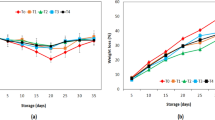Summary
Physiological studies were conducted on two varieties of potatoes — Ontario, which is susceptible to after-cooking blackening, and Kennebec — a variety which is generally free from this type of blackening.
The potatoes were stored at 50 F (10 C) and samples were removed for analyses every month. During the course of a year both varieties showed a gradual loss of ascorbic acid until the final sampling (July) when there was a slight rise. Ontario variety was consistently higher in ascorbic acid than Kennebec except at the June sampling.
The values for oxidation of ascorbic acid fluctuated and showed no definite relationship to propensity for blackening.
Turbidity of the extracts fluctuated during the year, showing a peak at the December sampling. The Ontario variety gave higher turbidity readings every month after the November sampling.
The Ontario was consistently lower in iodine-reducing values than the Kennebec potatoes.
Similar content being viewed by others
Literature Cited
Bowman, Ferne and Flora Hanning. 1951. A study of blackening and fluorescence in potatoes. Food Research 16: 462.
Hunter, Ann S., E. G. Heisler, J. Siciliano, R. H. Treadway and C. F. Woodward. 1957. After-cooking discoloration of potatoes: possible involvement of polyphenolic constituents. Food Research 22: 648.
Lewis, W. R. and D. M. Doty. 1947. Partial characterization of a compound involved in the blackening of white potatoes. J. Am. Chem. Soc. 69: 521.
Robison, Ursula M. 1941. Blackening of potato tubers on boiling. Nature 147: 777.
Rose, Dean H. and Harold T. Cook. 1949. Handling, storage, transportation and utilization of potatoes. A digest of information on the subject published mostly from 1938 to 1948. U.S. Dept. Agr. Bibliographical Bull. No. 11.
Tinkler, C. R. 1931. The blackening of potatoes after cooking. Biochem. J. 25: 773.
Tottingham, W. E., R. Nagy and A. F. Ross. 1936. The problem of causes of blackening in cooked potatoes. Am. Potato J. 13: 297.
Tottingham, W. E., Rudolph Nagy, A. Frank Ross, Jerry W. Marek and Carol O. Clagett. 1947. Blackening indices of potatoes grown under various conditions of field culture. J. Agr. Research 74: 145.
Wager, H. G. 1947. Quality of potatoes in relation to soil and the colour of the cooked potato. J. Agr. Sci. (England). 37: 270.
Yanovsky, E. 1955. The after-cooking discoloration of potatoes — a review. Eastern Regional Research Laboratory. Phila., Pa. U. S. Dept. Agr., Agr. Research Serv. Bull. ARS-73.
Author information
Authors and Affiliations
Additional information
University of Pittsburgh, Pittsburgh, Pa.
Based on data submitted by Premitha Weeratne in partial fulfillment for the degree of Master of Science.
Rights and permissions
About this article
Cite this article
Weeratne, P., Miller, E.V. & Murphy, H.J. Some observations on after cooking blackening of the Irish potato. American Potato Journal 41, 39–45 (1964). https://doi.org/10.1007/BF02863543
Accepted:
Issue Date:
DOI: https://doi.org/10.1007/BF02863543




